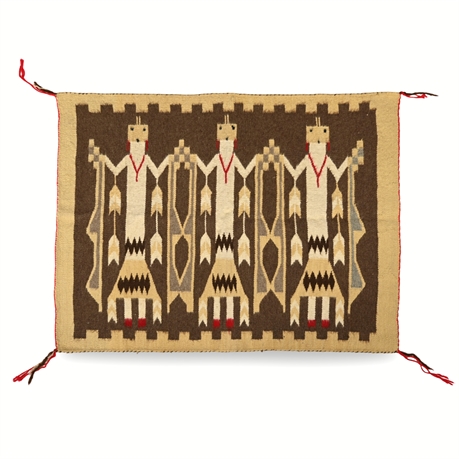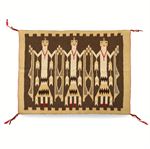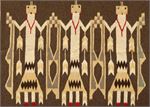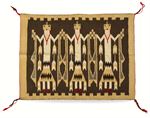Vintage Navajo Yei Wool Weaving — 4 Yei Figures with Feathered Staves 
Vintage Navajo Yei Wool Weaving — 4 Yei Figures with Feathered Staves, Earth-Toned Design
This vintage Navajo Yei wool weaving features four Yei figures standing in unison, each holding ceremonial feathered staves, symbolizing prayer and spiritual connection. The figures are adorned in cream-colored bodies with triangular-patterned kilts in black and brown, accented by red footwear and earrings. Their stylized geometric faces and linked hands reflect traditional Navajo artistry, while the symmetrical arrangement conveys a sense of unity and balance.
Set against a rich brown background, the cream, beige, and gray tones of the figures and staves stand out vividly. The design is framed by a stepped beige border, enhancing the composition’s structure. The weaving showcases the artisan’s attention to detail through the precise repetition of geometric shapes, such as diamonds, triangles, and arrow-like feathers, which are deeply rooted in Navajo symbolism.
This piece exemplifies traditional Navajo craftsmanship and serves as both a visually striking textile and a representation of Navajo cultural heritage, ideal for wall display or as a unique addition to any collection of Native American art.
Origin:
Handwoven by a Navajo artisan, this textile likely originates from the mid-20th century, a time when Yei imagery became increasingly popular in Navajo weaving. The Yei figures depicted are spiritual beings central to Navajo healing ceremonies, acting as intermediaries between the physical and spiritual worlds. The feathered staves they hold are symbolic of prayer and communication with the divine, reflecting the cultural significance embedded in this design.
Condition:
In good condition overall, with minor imperfections consistent with age. There are three isolated areas of moth damage, with the largest measuring approximately 1/8". These imperfections do not detract from the textile’s visual appeal and are typical for vintage wool weavings of this age. The weave remains tight and even, and the colors are well-preserved. The side ties are intact, adding to the textile’s authenticity and structural integrity.
Dimensions:
- Overall: 28" x 45"
The Story of Yei: Guardians of Harmony in Navajo Tradition
In the heart of the American Southwest, among the red mesas and vast deserts of Navajo land, there exists a belief that the world is guided by sacred beings known as Yei. These spiritual intermediaries, whose name is derived from the Navajo term Yeibichai, meaning “the gods’ grandfathers,” are revered for their ability to restore harmony, balance, and well-being. Their presence is not just a part of ancient lore—it is woven into the very fabric of Navajo life, culture, and art.
For centuries, the Navajo people have called upon the Yei during sacred ceremonies, particularly the Night Chant or Yeibichai ceremony. This nine-day ritual, passed down through generations, is a profound expression of Navajo spirituality. As the sun sets and the air fills with the rhythmic beat of drums, dancers emerge into the firelight, their feathered headdresses swaying in time with their movements. Each dancer embodies a Yei spirit, holding ceremonial rattles that echo through the night as prayers for healing and harmony rise into the stars. This ancient dance, performed with reverence and precision, serves as a bridge between the physical and spiritual worlds, ensuring that both individuals and the community remain in balance with the universe.
The imagery of these ceremonies has found its way into Navajo art, particularly in the intricate craft of weaving. Originally, Yei figures were depicted in sand paintings—temporary works of art created as part of healing rituals. Made from finely ground colored sands, these paintings portrayed Yei spirits with geometric precision, surrounded by symbols representing natural elements like rain, lightning, and corn. Once the ceremony concluded, the sand paintings were deliberately destroyed, releasing their spiritual energy back into the earth.
In the early 20th century, a new tradition emerged: weaving Yei figures into wool rugs and blankets. Inspired by the fleeting beauty of sand paintings, Navajo weavers began to create permanent representations of Yei that could be shared with the world. Using high-quality wool dyed with natural pigments, they transformed sacred imagery into enduring works of art. Each figure, carefully woven with vibrant colors and clean lines, carried the same spiritual significance as its sand-painted counterpart. Feathered headdresses symbolized communication with the divine, while the dancers' rattles represented the tools used to restore harmony. Even the borders of these weavings, often adorned with zigzag patterns and stepped motifs, echoed the natural forces of lightning and mountains—powerful symbols of the connection between earth and sky.
While these weavings were crafted for display rather than ceremony, their cultural significance remained deeply rooted in Navajo beliefs. Each rug became a visual narrative, telling the story of the Yei spirits and their role in maintaining balance within the world. As demand for Navajo textiles grew, Yei weavings gained recognition not only as beautiful works of art but also as windows into a rich spiritual tradition. Collectors and museums alike sought out these pieces, drawn to their striking designs and the stories they carried.
Among the most prized examples are those depicting Yei Be Chei dancers—human figures impersonating Yei spirits. These weavings often feature multiple dancers arranged in symmetrical rows, their colorful skirts standing out against neutral backgrounds. The vibrant reds, greens, purples, and browns of their garments contrast with the earthy tones of the wool, creating a visual rhythm that mirrors the dancers’ movements. Each figure is meticulously woven, from the feathers of their headdresses to the rattles held in their hands. The repetition of these figures, aligned with geometric precision, reflects the harmony and balance that the ceremony seeks to achieve.
Today, Yei weavings continue to hold a special place in both Navajo culture and the art world. Modern weavers, trained in techniques passed down through generations, continue to create these textiles using traditional methods. Each piece represents not only the weaver’s skill and dedication but also a connection to a spiritual legacy that has endured for centuries. The vibrant dyes, often derived from plants and minerals found in the Southwest, ensure that the colors remain vivid, while the tight weave of the wool preserves the design’s clarity and durability.
For collectors and enthusiasts, owning a Yei weaving is more than acquiring a piece of art—it is an opportunity to hold a piece of Navajo history and spirituality. Each rug serves as a testament to the enduring power of the Yei spirits, whose presence continues to bring harmony and balance to those who honor their traditions. Whether displayed on a wall or placed in a home, these weavings invite viewers to pause and appreciate the intricate beauty and profound meaning woven into every thread.
In this way, the legacy of the Yei lives on—not only in the hearts of the Navajo people but also in the art that continues to tell their story, bridging the past and present with every carefully woven figure.






